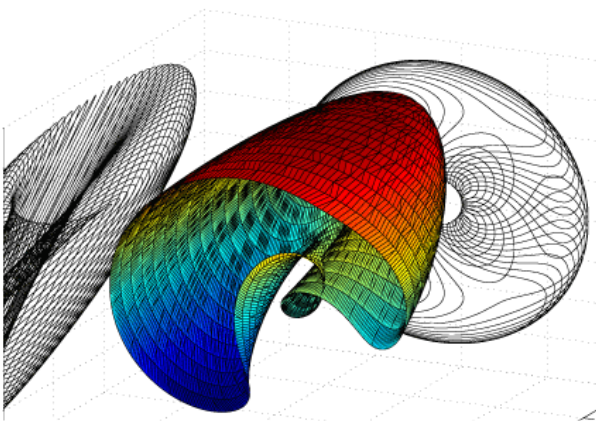Research
Complex Systems

Complex systems consist of devices with local dynamics and controllers that are coupled by physical or cyber networks. Such systems can exhibit elaborate collective behaviors, and are notoriously challenging to analyze or control due to their large scale and complexity of interactions. Our research is centered around control, optimization, and dynamics of complex systems, with particular focus in the following areas:
- Heterogeneous Ensemble Control
- Optimal and Distributed Control
- Nonlinear and Nonsmooth Stability Analysis
- Linear Control to Improve Nonlinear Robustness
Heterogeneous Ensemble Control

The goal of this work is to control a collection of heterogeneous devices so that their aggregate dynamic behavior matches a desired dynamic behavior as closely as possible, while satisfying local device limitations and network dependent constraints. This is a new but challenging problem due to nonconvexity and infinite dimensionality of the optimization problem required to perform the control design. Our approach combines a recent optimal control design technique based on reparameterization with novel finite dimensional function space approximations to arrive at tractable convex optimization problems for the design. The methods have been applied to control a dynamic virtual power plant consisting of a collection of distributed sources of renewable generation.
Relevant references:
- P. D. Grontas, M. W. Fisher, and F. Dörfler. Distributed and Constrained H2 Control Design via System Level Synthesis and Dual Consensus ADMM. Submitted to IEEE Conference on Decision and Control, 2022.
- V. Häberle, M. W. Fisher, E. Prieto-Araujo, and F. Dörfler. Control Design of Dynamic Virtual Power Plants - An Adaptive Divide-and-Conquer Approach. IEEE Transactions on Power Systems, To appear.
Optimal and Distributed Control

Optimal design of linear feedback controllers for devices distributed over a network is a difficult task, which becomes increasingly complex when devices are only able to communicate with their nearest neighbors. This project focuses on developing novel optimal and distributed linear control design techniques with provable closed-loop stability and convergence guarantees. Methods of design include approximations in complex function spaces, and consensus-based distributed optimization, where each device has a local estimate of global quantities which then achieve consensus.
Relevant references:
- M. W. Fisher, G. Hug, and F. Dörfler. Approximation by Simple Poles – Part I: Density and Geometric Convergence Rate in Hardy Space. Submitted to IEEE Transactions on Automatic Control, 2022.
- M. W. Fisher, G. Hug, and F. Dörfler. Approximation by Simple Poles – Part II: System Level Synthesis Beyond Finite Impulse Response. Submitted to IEEE Transactions on Automatic Control, 2022.
- P. D. Grontas, M. W. Fisher, and F. Dörfler. Distributed and Constrained H2 Control Design via System Level Synthesis and Dual Consensus ADMM. Submitted to IEEE Conference on Decision and Control, 2022.
Nonlinear and Nonsmooth Stability Analysis
 `
`
Engineered systems naturally experience large disturbances which have the potential to disrupt normal behavior. This work aims to identify the regions for stability and recovery from nonlinear and nonsmooth disturbances. Hyperbolic dynamical systems theory, including stable and unstable manifolds, as well as generic properties of vector fields, is used to develop a theoretical characterization of the behavior near the region of attraction boundary of a stable equilibrium point. This theoretical foundation motivates the development of numerical algorithms for assessing nonlinear stability in the presence of large disturbances, and helps prove theoretical guarantees for these algorithms.
Relevant references:
- M. W. Fisher and I. A. Hiskens. Hausdorff Continuity of Region of Attraction Boundary Under Parameter Variation with Application to Disturbance Recovery. SIAM Journal of Applied Dynamical Systems, 21(1): 327-365, 2022.
- M. W. Fisher and I. A. Hiskens. Numerical Computation of Critical System Recovery Parameter Values by Trajectory Sensitivity Maximization. In IEEE Conference on Decision and Control, p. 8000-8006, 2019.
- M. W. Fisher and I. A. Hiskens. Comments on “Stability Regions of Nonlinear Autonomous Dynamical Systems.” IEEE Transactions on Automatic Control, 66(12): 6194-6196, 2021. 4.
Linear Control to Improve Nonlinear Robustness
 `
`
One measure of nonlinear robustness is the margin for safe operation: the smallest change in operating conditions - including system state and parameter values - that would lead to a failure to recover from a given nonlinear disturbance. This project involves designing local linear feedback controllers in order to increase the margin for safe operation by moving the system further away from nonlinear instability. To accomplish this, techniques are developed which vary parameter values so as to increase the size of the region of attraction of a stable equilibrium point in the directions of the most dangerous nonlinear disturbances. Tools from modern dynamical systems theory are used to prove theoretical guarantees for the algorithms.
Relevant references:
- M. W. Fisher and I. A. Hiskens. Parametric Dependence of Large Disturbance Response for Vector Fields with Event-Selected Discontinuities. In European Control Conference, p. 166-173, 2019.
- M. W. Fisher and I. A. Hiskens. Numerical Computation of Critical Parameter Values for Fault Recovery in Power Systems. In Power Systems Computation Conference, p. 1-6, 2018.
- M. W. Fisher and I. A. Hiskens. Parametric Dependence of Large Disturbance Response and Relationship to Stability Boundary. In IEEE Conference on Decision and Control, p. 1821-1827, 2017.